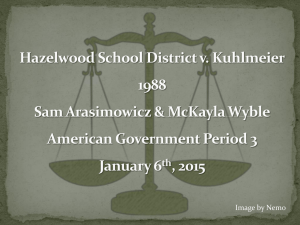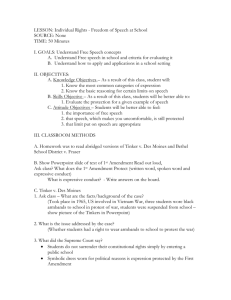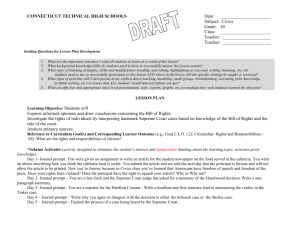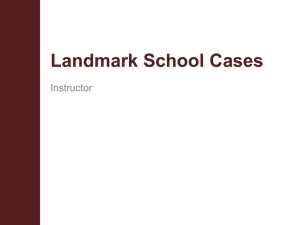HAZELWOOD SCHOOL DISTRICT v. KUHLMEIER
advertisement
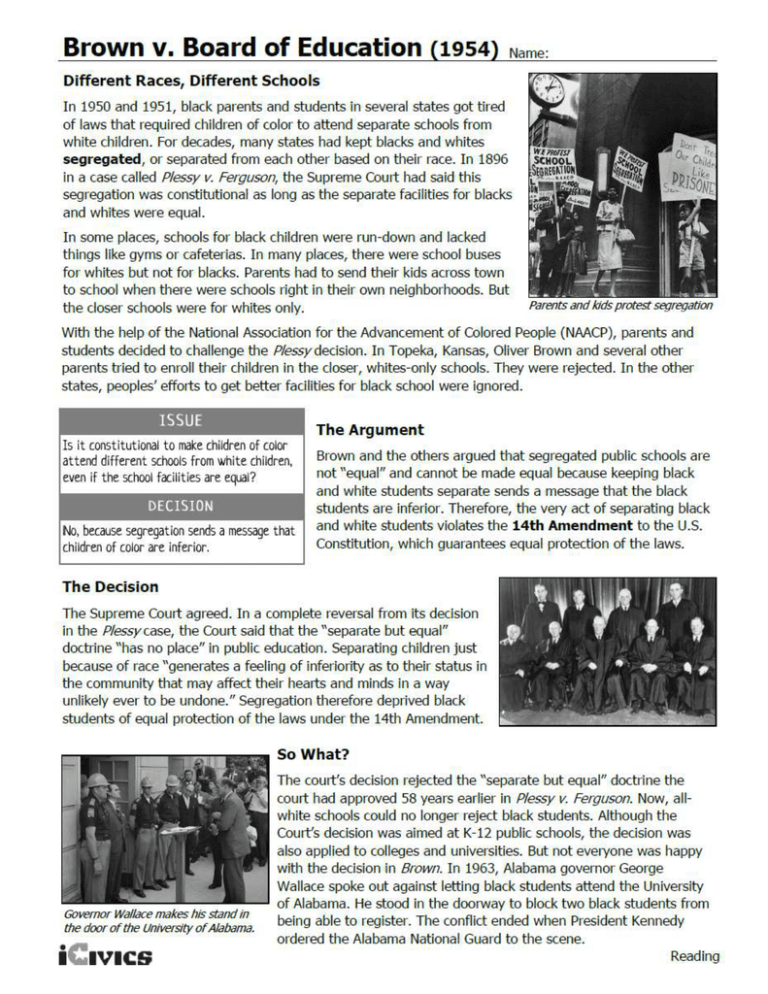
HAZELWOOD SCHOOL DISTRICT v. KUHLMEIER The Supreme Court’s 1969 ruling in Tinker v. Des Moines found that public school students had a First Amendment right to freedom of speech in the school. Did those rights extend to freedom of the press? Background of the Case Hazelwood East High School, near St. Louis, Missouri, had a school newspaper for students in its journalism classes. Before each issue, Principal Robert Reynolds reviewed the pages. While looking over an issue, Reynolds objected to two articles. One article was about three students who were pregnant. The other talked about one student’s experience with parents who were getting a divorce. No students’ names were used in the articles. Nevertheless, Reynolds felt readers could easily identify who the students were. For that reason, he canceled the two pages on which those articles appeared. Kathy Kuhlmeier and two other students who worked on the newspaper did not like this decision. They sued the school. They claimed that their First Amendment rights to freedom of the press had been denied. The Decision Relying on the Supreme Court’s decision in Tinker v. Des Moines, a lower court ruled in favor of the students. The school appealed the case to the Supreme Court. On January 8, 1988, the Supreme Court reversed this ruling. The Court drew a sharp line between individual expression— which it supported in Tinker—and the content of a school newspaper. Justice Byron R. White wrote: "A school must be able to set high standards for the student speech that is disseminated [distributed] under its [sponsorship] . . . and may refuse to disseminate student speech that does not meet those standards". -United States Supreme Court Justice Byron R. White Why It Matters The Hazelwood decision did not, of course, take away all First Amendment rights from school newspapers. Nevertheless, supporters of free speech and student interest groups said that the Hazelwood decision meant censorship. The Student Press Law Center reports that a number of schools, fearing lawsuits, have done away with student newspapers. Following this decision, some schools have even blocked the publication of student yearbooks. Others have moved to stop stage performances or to censor the content of student-based Web pages. United States V. Nixon 418 U.S. 683 1974 In November 1972, Richard Nixon won a second term as president, decisively defeating the Democratic candidate, George McGovern. But toward the end of the campaign a group of burglars broke into the Democratic Party campaign headquarters in Washington’s Watergate complex. Thanks in large part to the determined investigative reporting of the Washington Post, what had been a small news story soon expanded, as reporters uncovered tracks leading to high government officials. The Nixon administration denied any wrongdoing, but it soon became clear that it had tried to cover up the burglary and connections to it, connections that might even include the president. Under congressional and public pressure, Nixon appointed a special prosecutor. When it was learned that the president had secretly taped conversations in the Oval Office, the prosecutor filed a subpoena to secure tapes he believed relevant to the criminal investigation. In March 1974, a federal grand jury indicted seven associates of President Nixon for conspiracy to obstruct justice and other offenses relating to the Watergate burglary. The president himself was named as an unindicted coconspirator. The District Court, upon the motion of the special prosecutor, issued a subpoena to the president requiring him to produce certain tapes and documents relating to precisely identified meetings between the president and others. Although President Nixon released edited transcripts of some of the subpoenaed conversations, his counsel filed a “special appearance” and moved to quash the subpoena on the grounds of executive privilege. When the District Court denied the motion, the president appealed and the case was quickly brought to the Supreme Court. In the following portion of the Court’s unanimous opinion, the Supreme Court dealt with two key issues, the power of the judiciary as the ultimate arbiter of the Constitution, and the claim of the president that, in the name of executive privilege, he could choose to withhold materials germane to a criminal investigation. Chief Justice Burger reaffirmed the rulings of Marbury v. Madison and Cooper v. Aaron that under the Constitution the courts have the final voice in determining constitutional questions, and that no person, not even the president of the United States, is above the law. On August 5, 1974, transcripts of sixty-four tape recordings were released, including one that was particularly damaging in regard to White House involvement in the Watergate cover-up. Three days later, his support in Congress almost completely gone, Nixon announced that he would resign. http://teachingamericanhistory.org/library/document/united-states-v-nixon-1974/ TINKER v. DES MOINES SCHOOL DISTRICT Public school officials set standards of behavior that students are expected to follow. Does this arrangement leave students with any rights? Sometimes the Supreme Court must decide. Background of the Case One night in December 1965, a group of public school students, led by high school sophomores Christopher Eckhardt and John Tinker and eighth-grader Mary Beth Tinker, wore black armbands to protest the Vietnam War. As other students joined the armband protest, principals and members of the school board met the growing protest with a ban on armbands—to prevent “disturbing influences” at school. On December 16, 1965, Christopher, John, and Mary Beth were suspended for wearing their armbands to school. Their parents protested the suspensions in federal court. They contended that the students’ First Amendment right of free speech had been violated. The Decision On February 24, 1969, the United States Supreme Court in a 7–2 decision declared the school suspensions unconstitutional. Justice Abe Fortas, who wrote the majority opinion, first established that the students’ action was “akin [similar] to pure speech.” Even though their protest involved no speaking, he argued, it deserved “protection under the First Amendment.” In the key passage of the opinion, Justice Fortas wrote: "It can hardly be argued that either students or teachers shed their constitutional rights to freedom of speech or expression at the schoolhouse gate." -United States Supreme Court Justice Abe Fortas Why It Matters Supporters of the young protesters saluted the Court decision that “students are entitled to freedom of expression of their views.” Critics who opposed the wearing of the armbands predicted harmful consequences. Justice Hugo Black dissented from the majority opinion. He suggested that the Court’s decision was “the beginning of a new revolutionary era of permissiveness in this country fostered by the judiciary.” He argued that no one has a complete right to freedom of speech and expression. Later decisions, such as Bethel School District v. Fraser (1986) and Hazelwood School District v.Kuhlmeier (1988), narrowed students’ First Amendment rights. These rulings by their nature also expanded the authority of school officials.
